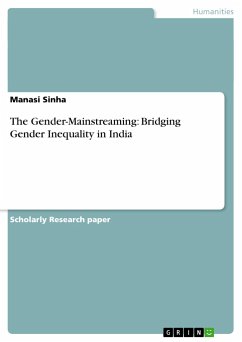
The Hijras. An alternative Gender Role in India

PAYBACK Punkte
0 °P sammeln!
Seminar paper from the year 2013 in the subject Sociology - Gender Studies, grade: 1,0, University of Trier, language: English, abstract: Still, in every culture there are people whose sex cannot be clearly identified or who do not identify with the gender that is designated for them. These individuals are in a state of liminality, which means that they are in a situation that is "ambiguous or indeterminate" (Boyd and Lassiter 218). The word liminality comes from the Latin word limen, which means "threshold". Hence, these people cannot exactly classify themselves as belonging to one or the oth...
Seminar paper from the year 2013 in the subject Sociology - Gender Studies, grade: 1,0, University of Trier, language: English, abstract: Still, in every culture there are people whose sex cannot be clearly identified or who do not identify with the gender that is designated for them. These individuals are in a state of liminality, which means that they are in a situation that is "ambiguous or indeterminate" (Boyd and Lassiter 218). The word liminality comes from the Latin word limen, which means "threshold". Hence, these people cannot exactly classify themselves as belonging to one or the other sex or gender. A famous example of such people are the hijras of India who represent an alternative or mixed sex/gender role since they "are culturally conceptualized as neither man nor woman, neither male nor female" (Nanda 2008: 461). The hijras, the so called third gender in India, are usually represented by biological males who take on a feminine gender or sexual role. They are "people whom we in the West would differentiate as eunuchs, homosexuals, transsexuals, hermaphrodites, and transvestites" (Nanda 1993: 175). However, a great difference between alternative genders in India and the West can be seen especially concerning their social acceptance. Our Western culture, "where ideas about sex and gender are conflated rather than viewed separately, [is] not well socialized to the possibility of gender variation" (Boyd and Lassiter 217), whereas the hijra's "role is so deeply rooted in Indian culture that it can accommodate a wide variety of [...] gender identities [and] cross-gender behaviors [...]" (Nanda 1993: 175). Why the hijras of India take an established role within Hindu culture, who they really are, and what their role in society actually is, will be presented in this work.













